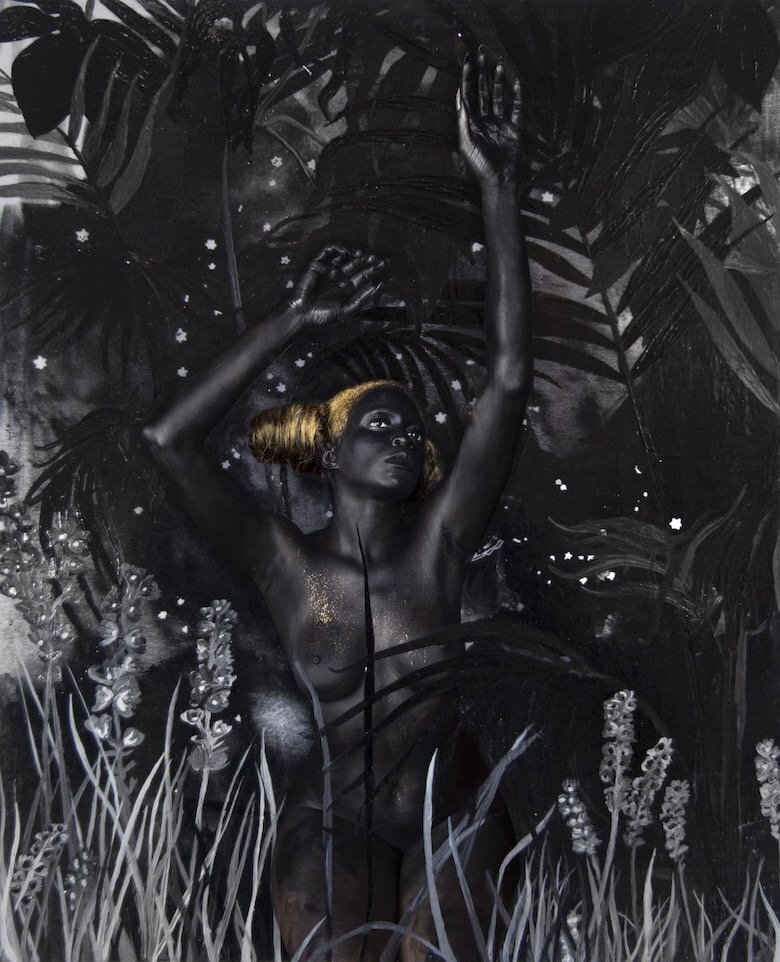Dark Testament | Lina Iris Viktor
One place I would have loved to visit this year is Fotografiska, especially to see Lina Iris Viktor’s new exhibition Dark Testament. First presented in Autograph (London), it is now a traveling exhibition presented in collaboration with Fotografiska.
Dark Testament is an immersive, installation by British-Liberian conceptual artist Lina Iris Viktor.
Composed around Viktor's evocative Dark Continent series, the exhibition is an excerpt of Autograph's recent exhibition Some Are Born To Endless Night — Dark Matter, and includes image projections of new works produced since.
Viktor’s photography is infused with curtail histories of the global African diaspora and preoccupied with multifaceted notions of blackness: as colour, material, and as socio-political consciousness. The photographs are then painted over and, with ancient techniques, gilded with 24 karat gold leaf to create a striking contrast.
In Viktor’s artistic universe, black is conjured as a deeply generative force: “I only see the absolute beauty and depth of black”, the artist states, ‘Black to me is the proverbial ‘materia prima’: the first matter, blackness as source, the dark matter that birthed everything.’ And beauty, in this arresting visual vernacular, ‘is forged from and within a restorative praxis of disavowal, as a radical method of transfiguration’, says curator Renée Mussai.
For Viktor, whose conceptual practice draws on a variety of artistic traditions and visual influences from European portraiture, classical mythology and astronomy, to ancient Egyptian and African symbolism, gold is both symbol and substance, a spiritual conduit of transcendence Viktor routinely deploys her own body in her figurative works, cast as the sole performer in a meticulously crafted cosmologywhere her body-as-canvas is abstracted through lustres of black and centred as the universal human form – a vessel through which narratives are woven, histories entwined, and possible futures imagined.
In the Dark Continent, a solitary female figure – shrouded in black paint, her hair golden – inhabits an imaginary monochromatic landscape of silver, grey and black hues, its deep lustrous blackness punctuated by luminous gilded solar/lunar symbols. At times contemplative and elusive, at times provocative and alluring, she occupies each frame seemingly absorbed in her own private reverie, yet occasionally challenges the viewer with a direct gaze, thus breaking the illusion of her isolated existence, and confronting inherent voyeurisms with a prophetic sense of foreboding. This body of work – which comprises Act I, II, III, IV as well Dark Testament and The Seven – represents an imaginary riposte to the nineteenth-century myth of Africa as the ‘dark continent’, a sinister place of danger and chaos. Playing with notions of colonial ‘discovery’, Viktor invites viewers to contemplate the meaning of darkness and light, through a communion of past, present and future tenses and a creative engagement of speculative visual fiction and the birthing of new mythologies… Accompanied by an extended caption-poem of exquisite, redolent image titles, the series’ existential
questions remain unanswered.
Throughout the exhibition, the Dark Continent’s tropical foliage is liberated from the confines of the painted still image and presented as black floor-based sculptures and wall stencils entitled Black Botanica (2019). The latest variations in the series subtitled The Seven – the final pieces currently still in production – are included as image projection, seen together for the first time.
Also featured in the gallery installation in a discrete gold enclave is Materia Prima (2016): the ‘mother work’ that inspired the Dark Continent series, and one of Viktor’s earliest large-scale figurative gilded canvas works. Here, Viktor appears as a commanding pan-cultural deity, emanating an aura of power,
authority and regality – her body posed against an intricate maze of elaborate signs and symbol, a coded vernacular that alludes to subliminal modes of communication and visceral forms of expression.
The extraordinary works brought together in Dark Testament constitute a bold reclamation of historical and transcultural reimagining, and the creation of all-immersive visual universes and symbiotic environments, in which to engage viewers with a transformative experience, and offer a space for reflection.
I love how Lina uses a variety of mediums to create her pieces, creating deep levels in each part of their artistic process. Everything has to be considered in the moment, and for what needs to happen next for the complete image. The pieces that are completely black, gold, and have white highlights feel more like paintings, whereas the ones that contain a hint of Lina’s natural skin tone offer a more personal hint to the image which I find just as appealing - and sometimes even making me more curious.
While being able to see some of these art pieces online, I would love to see the gallery so that I can see the layout of the prints - and the various sizes Lina works with and have the full immersive experience of the gallery setting.
Thankfully Fotografiska has created a 3D space of the gallery, allowing visitors to experience Lina’s amazing art pieces.
Click here to view the the 3D gallery
The virtual gallery has an autoplay feature, rolling through the space and looking at each piece. Although I found this too fast to absorb the images, and no text is supplied when passing over. Despite this, you are able to pause and manually view the art and the text that surrounds any certain artwork, but this disrupt the flow of the exhibition.
I personally do not think this exhibition works well online, purely because of how dark and mysterious the space is - and the ambiance is sadly lost in this 3D tour. Obviously the art gallery (and many others which are suffering during the lockdown measurements) is having to come up with new ways to engage the public and receive support, and as a creative wanting to find new artists and experience their beautiful work I am very thankful exhibitions are still active in engaging the public.
To view more of Lina Iris Viktor’s work,
Click here to access her website.






